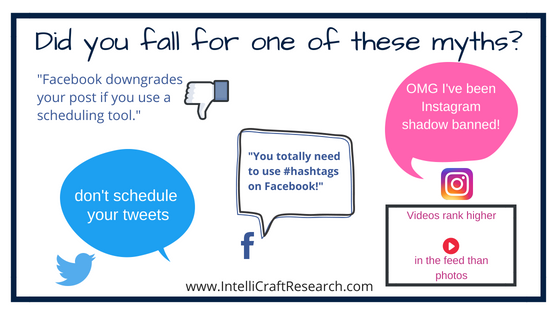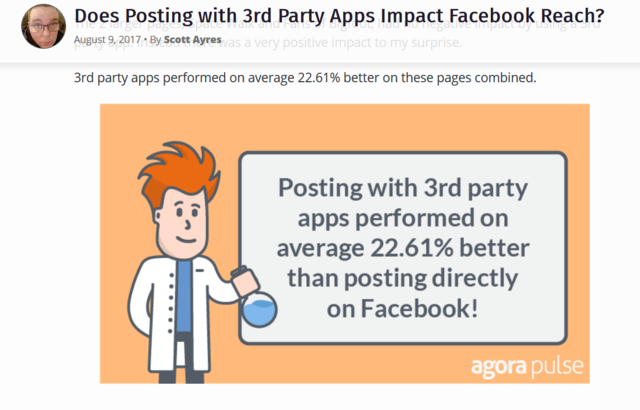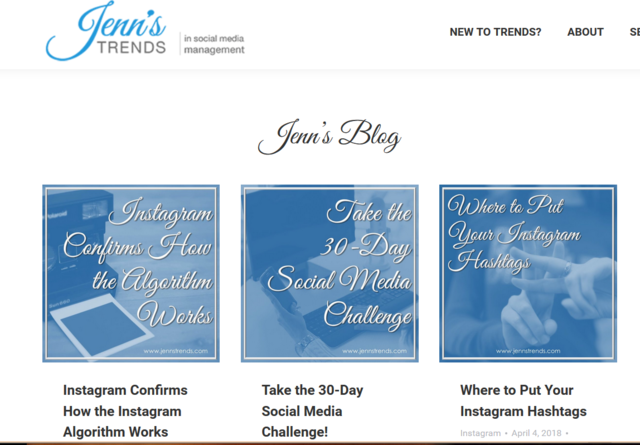Don’t Fall for These Facebook, Instagram or Twitter Marketing Myths
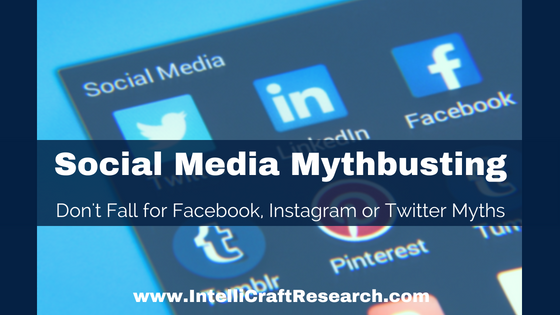
Check the Research and Don’t Fall for These Facebook, Instagram, or Twitter Marketing Myths Any Longer!
The only constant in social media and marketing is change.
Our favorite apps are constantly tweaking themselves. The algorithms that drive what we see on the platforms change. What content is deemed ‘engaging, changes. The apps and tools we all are using to connect socially, keep changing. The tools we use to track, post, and keep up with social media, those keep changing too. Change, and opaqueness, comes as part of these apps’ business models.
But news on social media changes is confusing and conflicting, leading to rumors and myths
Rumors abound. Since we each experience social media a little differently, we may not see the same changes at the same time. More rumors and myths are born. We’re often left guessing.
We’ve come to rely on social media as a big part of our marketing plans. Not knowing what’s going on in there is frustrating and scary. We’re susceptible to believing rumors, myths, and conspiracy theories.
Deep breaths. Knowledge is out there!
It IS possible to clear some of the confusion and bust myths around Facebook, Twitter, Instagram, and more
I don’t know all of the changes, new rules, new tools -but hey, I’m an info pro, so that means I know where to look and find some of that knowledge! I used some of those research skills after I crowd-sourced questions and common myths from my library, info pro, and nonprofit pals for an edition of my Marketing Tool Talk webinar series. I had sooooo much more info than I could fit in the lunch-n-learn webinar, so now it’s here in a series of blog posts you can all benefit from.
I’m going to bust those common rumors and myths for the big three: Facebook, Instagram, and Twitter. But first …
My Go-To Sources for Social Media Marketing News and Tips
- Social Media Today
- Social Media Examiner
- Jenn Herman, Instagram expert – Jenn has worked with Agora Pulse on some of their Instagram tests. She busted Instagram myths WAY ahead of anyone else. (and a friend got me in her private Facebook Group on social trends, so now I can ask questions directly! and YOU get the answers.)
- AgoraPulse’s Social Media Lab – this social media scheduling and metrics tool puts up serious money to run social media experiments
- Mari Smith – author, speaker, Facebook expert
- Kissmetrics blog – (while the tool and its independent web page have been absorbed by its parent company, you can still get to the blog here)
- HubSpot’s Marketing blog (they also have ones for Sales, Service)
I regularly check the blogs for the major 3rd party social scheduling tools as they give great advice (not specific to just their app) and because of their access to a TON of data they can run some good tests:
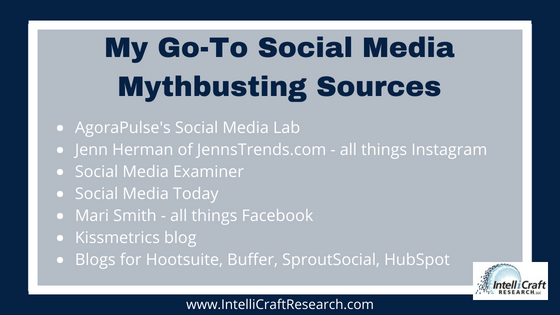
It’s social media myth busting time!
This post will list articles and resources that address some of the rumors, changes and biggest myths for at least 3 of the largest social media platforms. You sent me questions and requests – via social media, naturally! – on what you wanted to know more about. Some of the more general social media myths will be addressed in a separate post.
Facebook Myths
We could consider Facebook Myth #1 to be “our organization doesn’t need to be on Facebook” or its flipside, “everyone’s on Facebook, so we must be too!”
Because with 2 BILLION monthly active users – it’s hard to ignore or not be on Facebook as part of your social strategy. Your users, patrons, and donors ARE on Facebook. How often they use it, or see your messages, or want to hear from you there … those are all still open, valid questions.
It was considered ‘free’ marketing for so long – so friendly to small businesses, schools, nonprofits, and causes with limited budgets. But NO marketing tool is ever really free, right?
Ubiquity and our reliance on FB is why all the changes FB makes hit us so hard and really dent our use of this platform in marketing plans. Before mythbusting and offering tips – here’s your friendly reminder that Facebook (and any other social app) can NOT be your homebase on the web, nor your primary marketing tool. Don’t forget that any and all social tools are businesses and answer first to shareholders, VCs or whoever their funders are – not users. Not us. Don’t put all your eggs in 1 social basket. <end soapbox rant>
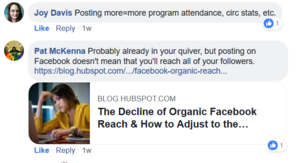
I asked my library colleagues to share social media myths – naturally, via social media!
Facebook Myth 2: “Organic reach is dead, no one sees our posts anymore”
Well … this one’s not really a myth as it’s mostly true. 🙁 🤷♀️
By 2017, organic (nonpaid) reach had fallen to around 2%, (for comparison, it was around 15% in 2012) and for some big Pages, even lower. BUT other brands and FB Pages have seen higher than 2% organic reach.
A related myth or long-gone piece of advice used to be – ‘Just keep posting on FB and eventually you’ll reach all your followers.’
Nope!
Heck, this wasn’t even true several years ago before Organic Reach really took a nose dive. That advice is a straight up myth itself now – get used to not reaching many or most of that large # of fans your page spent years building. I know, I know, it’s super frustrating. Remember the bit above about how Change is at the very core of social media (and really all marketing tactics today)? It’s over and done – the social rules changed. And don’t’ forget, who’s business social really is.
Here’s another point – what is ‘organic reach’ on Facebook anyway? It’s what FB says it is. <eyeroll> and how they’ve defined and measured it has changed.
What’s going on, and more importantly, what do we do?
The TL;DR answer: ‘less is more’, ‘quality not quantity’, ‘don’t be boring’, ‘don’t over promote’, and ‘money talks.’
One of the more counter-intuitive pieces of research and advice – shared by many social experts recently – is to post LESS to Facebook. But post wiser, better, and of higher quality. Moderate frequency, quality content, high relevancy, and consistency matters. Buffer did a study on this too – they saw their reach and engagement go WAY up – with FEWER posts. :-0
The longer answer on what to do about Facebook? That’s going to need its own post!
Facebook Myth 3: “FB downgrades scheduled posts”
Nope. Not true. AgoraPulse’s Social Media Lab busted that.
Go ahead and use tools like Hootsuite, Buffer, SproutSocial, PostPlanner, or AgoraPulse. I’ve discussed social scheduling tools several times – for my column in the Marketing Library Services Newsletter, in my webinars, and over in my recommended marketing tools list.
Facebook Myth 4: “you should use #hashtags on Facebook – why else would they be there?”
Well, hashtags exist on FB because FB has loooong had a habit of copying what other social platforms are doing so that people don’t leave FB. And if that doesn’t work, they often buy the other app. 😮 😆
Several social expert sources have studies this and the data says NO, don’t use #tags on Facebook. Or maybe only use in paid ads. Or use them ironically. 😉
- Buffer did hashtag research that showed “FB posts without hashtags fare better than those with a hashtag.”
- Buzzsumo’s research of over a BILLION Facebook posts came to same conclusion – don’t use tags on FB.
- slight caveat – some big name marketing sources, like Hubspot, do recommend judicious, strategic use of hashtags. AdEspresso, from Hootsuite tested hashtags in FB ads and saw them do well.
Facebook Myth 5: is a FB/Instagram cross over myth – “posts shared from Instagram to FB have fewer views than pics shared directly to FB”.
Instagram and social experts say …
generally there’s no reason a “network will expressly state one post type is favored over another … You’d need to run your own tests – controlling for variables, over a length of time (like a month), with similar content, mixing up post times, and then see the average views for each post type. BUT point is, there’s no real data out there officially that supports that rumor.” (Mike Allton, Brand Evangelist at AgoraPulse; he answered this question in the private FB group from Jenn Herman).
And Jenn Herman weighed in on this question to say in her experience, “a post shared from IG to FB will get MORE reach. FB wants to keep you in their family of apps…. But your own testing is always ideal.”
Moving on …
Instagram Myths
There are more than 800 MILLION monthly active users now on Instagram. It’s been growing VERY quickly – exponentially. That’s a LOT of competition and clutter of posts, potentially. With that many users posting things, it’s natural your reach and engagement stats may be down vs. years past. Like every other social platform (and esp ones owned by Facebook), Instagram is constantly tweaking its services and algorithm. And it’s becoming a bit of ‘pay to play’ over on Instagram, like it has become on Facebook.
Instagram Myth 1: “shadow banning”
aka the nefarious, mysterious reason people say their Instagram reach plummeted and they think they aren’t showing up in searches on the app – because somehow IG ‘banned’ them.
People have claimed that “You and people who are following you will see your posts in hashtags but other people will not” or that it affects business profiles, or that using certain tags gets you ‘shadow banned.’
Now, I’m no Instagram expert. But I know folks who are! 😊 And I can get answers …
There. Is. No. Such. Thing. As. Shadow. Banning.
My pal who is an Instagram expert (we did an Instagram edition of my webinar together – go check it out!), and hangs with even BIGGER experts, is constantly pointing people to great articles from Jenn Herman.
- This one that takes down the biggest of Instagram myths
- Or her separate treatise on how there’s no such thing as shadow bans.
- Jenn also did a post and video interview with major social/marketing software company Tailwind, taking down this same ‘shadow ban’ myth.
Jenn works with AgoraPulse’s Social Media Lab on their Instagram testing, collecting large sets of data to test all these rumors and myths against. Jenn even has a Master’s in Forensic Science, so yeah, she’s a smart gal worth listening to.
Bottom line is that Instagram does NOT hide your posts in hashtag searches. Banning is a myth.
Instagram Myth 2: “Instagram bans certain hashtags”
Eh, no. ‘ban’ isn’t really the right word.
Sometimes hashtags get co-opted for less than positive purposes and so Instagram chooses to not pass traffic through from those tags. The tags still exist, they do NOT affect any other tags you use in a post, they do NOT negatively affect your account for using them – you just can’t search Instagram and see content that is using one of the ‘banned’ tags. And which tags are ‘banned’ or not keeps changing.
I won’t even link to the bloggers and articles that have shared these myths – just know if you see an article with scare tactics like this, put on your media literacy hats and think twice!
Odd but true fact that came up from my pal, and Instagram expert, Ken, during our webinar:
“Instagram often has to put in ‘time out’ some generic tags like #christmas, #easter, #newyears – often because they are used a massive number of times, and are the ones must likely to get nefariously jacked. Used by bots, spammers, porn, or other activities that go against Instagram’s ToS. These tags still exist, sometimes can still search them – but Instagram isn’t passing current traffic to these ‘time out’ tags. Tags can be reported for that and suspended. Instagram regularly goes in, reviews, and ‘cleans’ up.”
What to do instead?
- Don’t use generic, overly broad hashtags. Use #christmas2018, #newyears18
- Create and use your own branded tags
More from my pal, and his Insta-experts crew, on questions raised by articles about ‘banned hashtags’:
“If for some reason you use a banned hashtag, it means you won’t get the traffic from the hashtag that you might normally get. Has no impact on your account, or the other hashtags, or post itself except for possible lower engagement because you are not getting the traffic.”
While we’re talking hashtags on Instagram –
Instagram Myth 3: “cram hashtags into those Insta posts” and alternately I’ve heard “eww, do we have to use so many tags on Instagram?!”
Ok, just because you could use up to 30 per post doesn’t mean you should. In their respective posts on hashtag strategy and research, Buffer and TrackMaven (as reported in SocialMediaToday) show an average of 10 to be optimal. TrackMaven also found longer hashtags (21-24 characters) to work best for engagement. Test these strategies out on your own accounts and monitor your metrics.
[FYI: TrackMaven has put their report behind an opt-in/lead generation wall – sorry. BUT – the Kissmetrics 2018 Instagram trends report has a few snapshots of charts and data from the TrackMaven study.]
Instagram Myth 4: “we don’t need a business Instagram account” or “what’s the difference with a business account anyway?”
Some users, marketers, and brands had fears that since Facebook owns Instagram, and FB has recently prioritized friends over brands, that the same applies to business profiles on Instagram. Small business and small organizations who were hit so hard by the FB Newsfeed changes feared the same for IG. So, myths swirled around business accounts and organizations stayed away.
Fear no more! Not true. No penalties for having a business profile or account. And business profiles or brands are not ranked higher either. All accounts are equal. Instagram said so themselves in that June 2018 announcement/interview with journalists [read about the Instagram algorithm from TechCrunch or from Hootsuite].
But why switch to a business profile?
- Access to greater analytics is a BIG reason. Really knowing who your audience is on Instagram and what they react to is a positive thing. More analytics the better!
- Access to features unavailable to personal account – like being able to promote a post.Or schedule one.
- To schedule posts directly to Instagram you need to be using a business profile on the platform, and then go with an official Instagram partner (since Instagram has long been notorious for locking down its API and access to data and workings for 3rd party tools).
- Instagram Ads. Because the ads you build on FB can transfer to Instagram and its 800M active users/month. If you want more on the Why and How for an Instagram Business Profile, read this post from Sprout Social or this nice infographic from Later.
You can read more on the reasons for a business profile from the folks at Social Media Today. Or take tips from the experts at HubSpot on how to optimize Instagram for business.
Let’s talk more about that big Instagram interview …
Myths and rumors busted when Instagram finally peeled back the curtain on its algorithm to reporters in early June, 2018 (and confirmed most of what Jenn Herman has been saying for more than a year). The interview busted a LOT of the rumors/myths I’ve hit on, as well as gave other info and tips:
- NO preference given for videos vs. photos in ranking. Depends on each user and how they interact with content.
- Instagram doesn’t hide content. IF you scrolled back far enough you’d eventually see every post from every person you’ve followed.
- Interactions with Stories and Live feed from an account does NOT impact the rest of the content from that account – i.e. someone watches all your stories, but doesn’t interact with your photos (regular content), your photos/regular content is not going to show up any higher in that follower’s feed, it will be still be buried low.
- Using Instagram Stories doesn’t boost your placement in feeds. Nor Live video or Boomerangs.
- NO punishment for posting frequently. People just may not see your posts together or in order. (that’s separate from some experts recommendations on how often to post and that LESS is better).
- NO negative impact if you switch to a business profile. Reach stays the same. [so just go do this so you can have access to the extra analytics and posting tools!]
- Lesser known fact – Instagram’s feeds are more personalized and operate quite differently from Facebook – such that the “overall popularity of a post has very little impact on the placement in individual’s feeds.” A pic on Instagram can be SUPER hot popular with a lot of people who follow a brand, but because YOU rarely interact with that brand you follow, the hot pic is not more likely to show up high in your feed.
Last but not least …
Twitter Myths
330 Million monthly active users – not anywhere near as large as Facebook or Instagram, though there are 3 Billion accounts on Twitter. Active Twitter users trend younger and tend to be power users. 81% of millennials check Twitter at least once a day. Twitter is popular among journalists, celebrities, politicians, authors, and many other niches – and it’s the place for trending news. If I want to check out the discussions, arguments, flashpoints among sub-groups in library and info land, or what nonprofit experts are talking about – I head to Twitter. #critlib (‘critical librarianship’) #scholcomm (‘scholarly communications’), #radlibchat, #librarylife
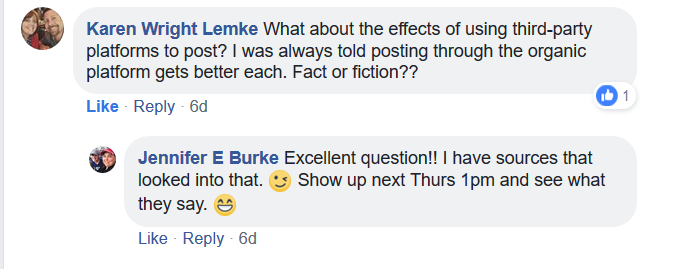
Glad I could answer this question and bust a social myth!
Twitter Myth 1: “Twitter downgrades scheduled Tweets”
Nope.
Agora Pulse Social Media Lab busted this. They ran a big experiment using multiple common SM schedule tools and measuring Impressions – and it came out a draw. Some of the accounts tested fared better with scheduled posts, other accounts saw slight decrease. And all the accounts saw an increase in followers, not something part of the test design!
Feel free to dive into the geeky statistical analysis he does, but the TL;DR = Go ahead and use those schedulers!
Twitter Myth 2: “We should follow/unfollow and really boost our numbers” or relatedly, still being on #TeamFollowBack.
(aka instantly or automatically following back ANY account that follows yours)
Bad practices and bad advice more than straight myths.
Don’t be a social a$$, don’t do the Follow/Unfollow! It’s icky, bad form, spammy. I personally don’t recommend that kind of churn and for sure don’t use any automated tools to try this!
But does it work?
You want data, see the Agora Pulse Social Lab Twitter experiment. Sadly, the data says the strategy WILL increase your follower counts and maybe your engagement – but at what cost? Are these the right kind of followers? Your ideal audience? Will they stick around? Be careful how you use this! You especially should NOT use 3rd-party tools or apps that automate the follow/unfollow in quick fashion – doing goes against the Terms of Service of a bunch of apps and can get you in trouble with them and Twitter.
Twitter Myth 3: “use more hashtags!”
Twitter is not Instagram, where more hashtags (to a point) really does work. Hashtags ARE important on Twitter, but should be used in moderation. 1 or 2 tags per post, max.
- There’s research (Buddymedia) that says using more than 2 #hashtags on Twitter leads to 17% drop in engagement (note: Twitter did its own research that confirmed this, but both Twitter and the Buddymedia study are several years old – we need to find more recent data too). Tweets with only 1 or 2 #tags have 21% MORE engagement than tweets with 3+ tags.
- TrackMaven has a more recent study (2016) that showed Tweets with only 1 hashtag generated the most engagement, and it’s a classic-looking long-tail drop off after that for tags. (the full study is behind an opt-in wall, but SocialMediaToday has nice hashtag strategy post and summary of the TrackMaven research, with that longtail chart).
- Buffer has a round-up post on hashtag strategy including many of these studies.
All of these various studies and posts on hashtags that I’ve referenced under each platform point to one of the big reasons you can NOT treat these key social media tools the same. You really should never cross-post the exact same thing to Facebook, Twitter and Instagram. Besides having different audiences, they have different customs or cultures, and what may be shared/commented on/liked/tagged on one platform won’t have same effect on the others. And anyone seeing that post will know you aren’t paying attention and you’re just automating. There’s a time and place for using automation – gracious, we couldn’t manage social media marketing without it – but automate wisely and custom to each platform.
Bonus myth/rumor … Snapchat
“Snapchat is dead.”
“Snapchat is where the teens are, we gotta be there.”
“What’s up with Snapchat??”
All may actually be viable, all may have air of fiction to them. And I also have no idea what is up with Snapchat!
Snapchat HAS slowed its user growth and lost users – that update and overhaul to the platform was VERY unpopular. Snapchat only has about 190 million daily active users and 30 million active monthly users – compare that to the numbers I shared above for the 3 biggest social platforms.
As a company it’s in some financial trouble. And across the entire spectrum of marketers, it’s not popular and marketers are quite wary still of Snapchat. Users love the disappearing, short-lived content; marketers dislike that very aspect.
Sure, teens still use Snapchat. But they maybe do NOT want to interact with you as a brand on Snapchat. If you were a sneaker, makeup, music, fashion or sports brand, they might. 😊 And with limited analytics (only rolled out spring 2018), how will you know if they DO start to love you on Snapchat? IMHO (and that of some social media experts) – Teens also love Instagram and it’s easier to make marketing work on Instagram, and your efforts don’t disappear there.
Buffer did a side-by-side comparison on if a business should use Instagram or Snapchat for marketing – and like much else, the answer is “it depends.” Even the social experts like SME (Social Media Examiner) say it’s ok to bump Snapchat low on your list of potential marketing channels.
One Last Social Media Tip For Now
Not so much a myth as an admonishment to do better on Twitter, Facebook – and the other social platforms- and remember it’s SOCIAL!Ya know, friendly, collegial, connecting for conversations? Well, that’s still what most of us hope and wish it was on average basis.
In terms of marketing, stop the proverbial ‘shouting’ and doing nothing but posting events and links back to your website. Social media doesn’t work well as an extension of your library’s bulletin board or flyers posted on walls.

A library cleverly showing personality on social media! Way to go Royal Irish Academy and Sophie (SM manager)
Mix it up! You’re on social to listen, have conversations, and engage.
Ask questions.
Run a poll.
Share useful content from another local organization.
Use GIFs or meme images – wisely, and judiciously. It’s really, truly ok – required even – to have a human personality on social media and act like a human. That means humor.
Participate in relevant Twitter chats.
Do a Facebook Live and answer a common question. Repeat that every Tuesday maybe.
Take time to listen, watch, and understand how Twitter and its social ‘ecosystem’ is different than Facebook or Instagram or the others.
Do connect and post with hot or trending topics – in ways that are relevant to your org. Hop in public conversations that mention your org/brand/city.
Don’t believe everything you hear about social media marketing!
We’re good at doing info literacy and media literacy in other parts of our work, time to apply that healthy skepticism to social media too. These platforms ARE businesses, most aggregate user data and use that to target ads our way, and their business models aren’t transparent. But that doesn’t mean we should buy into rumors, conspiracy theories, or think the algorithms are jacked and out to get us.
Want help going over your library or nonprofit organization’s social media strategy? Would your staff love some hands on training on busting social media myths? Contact me and let’s bring simple, approachable, fun training to you!
